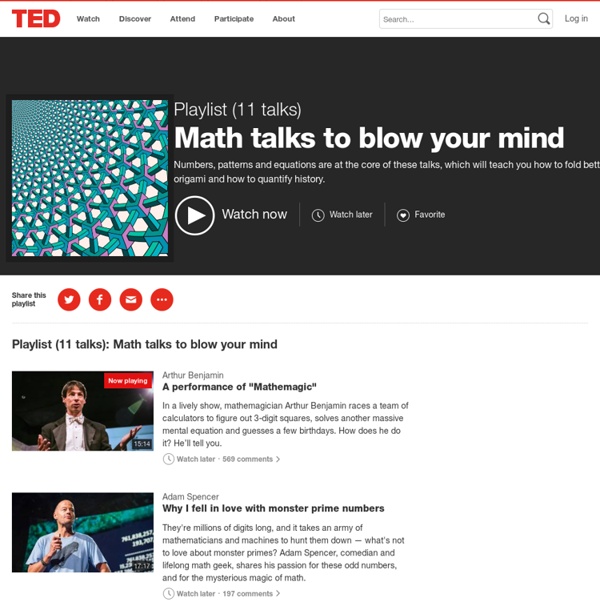



http://www.ted.com/playlists/189/math_talks_to_blow_your_mind
Related: Matte • MatematikStiftelsen Marcus och Amalia Wallenbergs Minnesfond Background The Foundation wants to contribute to the advancement of teaching excellence in Swedish schools. For that purpose we envision a long term program that provides devoted teachers challenging, inspiring and advanced teaching experiences and studies overseas. The ”Pilot 2014” made it possible for 6 teachers to participate in the “Stanford Summer Teachers Institute” at Stanford University in California US during one week in combination with talks and presentations from Stanford Faculty, participate in other Stanford Summer activities and visit other schools and laboratories. Invitation For the summer of 2015 the Foundation will invite another group of 6 teachers to participate in the Stanford Center to Support Excellence in Teaching (CSET) program. The Swedish teachers will participate in the CSET courses given the week of July 6-10 2015, which are described on the web-site Stanford CSET Teaching Institute 2015 Course Descriptions
Graphing Quadratic Equations A Quadratic Equation in Standard Form (a, b, and c can have any value, except that a can't be 0.) Here is an example: Graphing You can graph a Quadratic Equation using the Function Grapher, but to really understand what is going on, you can make the graph yourself. Read On! Outline of futurology The following outline is presented as an overview of and topical guide to futures studies – study of postulating possible, probable, and preferable futures, and the worldviews and myths that underlie them. It seeks to understand what is likely to continue, what is likely to change, and what is novel. What is futures studies?[edit] Futures studies can be described as all of the following:
Blooming Zoetrope Sculptures The placement of the appendages on these sculptures is critical to the success of the animation effect. The positions are based on a specific phyllotaxy (i.e. leaf order) used by nature in a number of botanical forms, including pinecones, pineapples, sunflowers, artichokes, palm trees, and many succulents. The photo above shows just such a succulent. I have numbered the leaves from youngest to oldest. If you follow the numbers in sequence you will find that each leaf is approximately 137.5º around the core from the previous leaf. 137.5º is a very special angle, called the golden angle, based on the golden ratio. Smarter Balanced Assessments The Smarter Balanced Assessment Consortium is developing a system of valid, reliable, and fair next-generation assessments aligned to the Common Core State Standards (CCSS) in English language arts/literacy (ELA/literacy) and mathematics for grades 3-8 and 11. The system—which includes both summative assessments for accountability purposes and optional interim assessments for instructional use—will use computer adaptive testing technologies to the greatest extent possible to provide meaningful feedback and actionable data that teachers and other educators can use to help students succeed. Smarter Balanced assessments will go beyond multiple-choice questions to include extended response and technology enhanced items, as well as performance tasks that allow students to demonstrate critical-thinking and problem-solving skills. Performance tasks challenge students to apply their knowledge and skills to respond to complex real-world problems. Assessment System Components
21 GIFs That Explain Mathematical Concepts “Let's face it; by and large math is not easy, but that's what makes it so rewarding when you conquer a problem, and reach new heights of understanding.” Danica McKellar As we usher in the start of a new school year, it’s time to hit the ground running in your classes! Math can be pretty tough, but since it is the language in which scientists interpret the Universe, there’s really no getting around learning it. Check out these gifs that will help you visualize some tricky aspects of math, so you can dominate your exams this year.
Bootstrap: Materials Curriculum and Software Bootstrap:1 applies mathematical concepts and rigorous programming principles to creating a simple vidoegame, and is aligned to Common Core Standards for Mathematics -- including the new standards for Mathematical Practice! Bootstrap:2 goes deeper into programming, building events and data structures on top of the foundation laid by Bootstrap:1 and allowing students to build far more sophisticated programs. A Focus on Fractions: Bringing Research to the Classroom, 2nd Edition (Paperback) About the Book A Focus on Fractions is a groundbreaking effort to make the mathematics education research on how students develop their understanding of fraction concepts readily accessible and understandable to pre- and in-service K– 8 mathematics educators. Using extensive annotated samples of student work, as well as vignettes characteristic of classroom teachers’ experiences, this book equips educators with the knowledge and tools to revealstudents’ thinking so that they can modify their teaching and improve student learning of fraction concepts. A Focus on Fractions 2nd edition includes sections on the Common Core State Standards for Mathematics and the Ongoing Assessment Project (OGAP) Fraction Framework integrated into each chapter as well as a new chapter on the OGAP Fraction Progression and how it can be used for formative assessment purposes. Special Features: Reviews